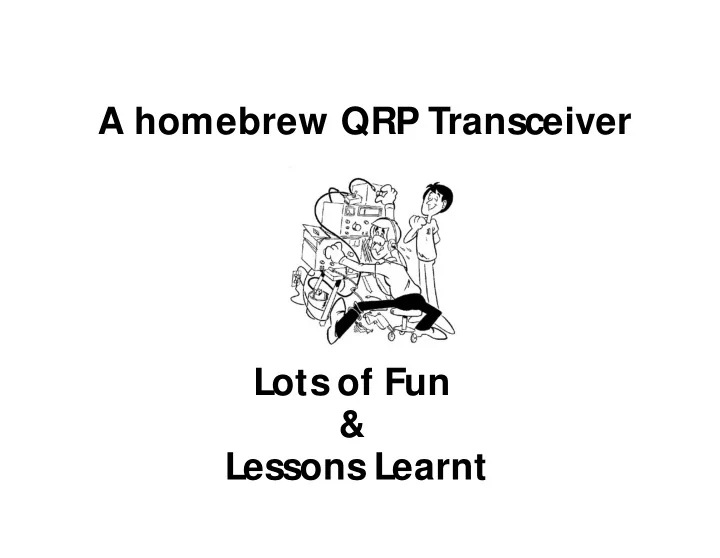

A homebrew QRP Transceiver Lots of Fun & Lessons Learnt
Background • In 2008 I was transferred to a new location. • I could bring 2 suitcases along and spent 5 months in an apartment until the container with all my stuff arrived. Finally! • Enough time for reading though the complete ARRL handbook in detail.
NorCal Sierra: ARRL Handbook
Sierra: Schematic
Idea: Why not make an own rig? • Challenge: a homebrew TRX – No simple copy n paste approach – Some modifications of original circuit – Target: performance – No thrills n whistles (at least in first stage) • 15 meter band – DX band – antenna size / performance
Some requirements • Use of junk box parts – Chassis – Laptop power supply – Variable capacitor – DBM – Heat Sinks • Construction techniques: – M anhattan, Dead bug, SM T ..
Basic Design: simple Increasing Complexity Direct Conversion Superhet single conversion multiple conversion (V)XO VFO S ynthesizer CW only SSB FM , AM AGC M GC IF filtering AF filtering - NB, S-M eter digital display -
M odifications: some details – Frontend : RF preamp / DBM / diplexer / IF amp instead of active NE602 mixer – 3 pole Xtal filter – audio filter: switchable bandwidth – AF amplifier – Frequency management: down conversion • VFO: 3.28-3.44 M Hz PM O: 16.08- 16.24 M Hz • PM O-Xtal 12.8 M Hz IF: 4.9152 M Hz (Sierra, K2) – P A: IRF 510 FET 3.5 W output – RX/ TX switching with relay
Replacement - Complexity • Replacement of active NE 602 mixer by a DBM – DBM : passive mixer with conversion loss i.e. additional amplifier stage needed – Resizing of filter / diplexer frequencies software simulation, experimental verification
T est gear • Oscilloscope • Receiver – detection of spurs, oscillator drift… • and some homebrew equipment – Dummy load / power measurement – Oscillator for Crystal measurements (Xtal filter) – Sweep frequency generator (filter measurements) – Capacity and inductance meter
Summary • What looks quite easy on paper too often turns out to be “somewhat” more complex in reality • Combining circuit boards too often takes more time than soldering together the boards • Grounding has an effect / some circuits don’t want to work … … … ..
1 year later: the Outcome Single band CW Transceiver 21.00 - 21.16 M Hz Receiver: Single conversion superhet RIT Variable RF gain 500 Hz IF Xtal filter Switchable audio filter Transmitter: 3.5 Watt output
Insights: The top VFO P A (IRF 510) RIT 8 V supply TX-mixer (PM O + IF) PM O-mixer (VFO + 12.8 M Hz)
At the bottom RX/ TX relay LPF RX preamp / filter IF amplifier-diplexer-DBM Product detector-Xtal filter RX/ TX switching audio amplifier AF filter (100, 180, 350 Hz)
Crucial: Antenna coax fed sloping dipole – From 1 st ����������������������� – t ������������������������������������
What is “QRP?” • A telegraphy Q-signal – “QRP” = T o lower ones power – “QRP?” = Can you lower your power? • QRP Operation – CW: 5 Watt RF output power (or less!) – SSB: 10 Watt PEP • QRPP / miliwatting < 1 Watt output Page 17
Some theory: 5 % of 100 W… … . Only 5 watts? You must be kidding... 100 Watt: S 9 signal 100 W 0 dB 10 W - 10 dB 5 W - 13 dB 5 Watt: 5 Watt: S 7 1 W - 20 dB S-meter: 1 unit � 6 dB
Operation with 3.5 W • Within ½ year more than 50 countries from YB • From “round the corner” to real DX • HR, OY , 5X, CT3, ZC4, 4K, A6, A7, GI, VE3, K2, 5Z (No contest QSO’s!) • Short band openings (3/ 4 h) to Europe almost every day i.e. 0.3-0.4 W / 1000 km • Several 2 way QRP contacts A4, RA1, DL, JA • Learning: Improved own operational skills
Have a Try – First steps • Play with attenuator button: – 16 dB correspond to power reduction 100 W � 4 W • Listen on QRP frequencies • T est: reduce transmitting power – Are you still heard? • Less interference -> happy neighbours
Another toy of my shack • rather simple design • nevertheless High Performance • several options: 100 W P A, tuner, digital filter
Some References/ Links www.gqrp.com www.qrparci.org www.qrpproject.de (also in English!) www.qrp.pops.net Frank W. Harris, KØIYE 2006: CRYSTAL SETS TO SIDEBAND A Guide to Building an Amateur Radio Station W1FB’s QRP Notebook ARRL Handbook Experimental M ethods in RF Design
High End Homebrew
Next on the agenda • August/ September: QRT in 9V • Later on: QRV from YB land
Garage Sale Gain: 10 m 6.1 dBD, 15 m 4.2 dBD, Heathkit SB 221 20 m 3.5 dBD 2 x 3-500Z Triodes ca. 3 dB below full size 3 ele 80, 40, 20, 15 m bands Yagi (ca. ½ S-meter level) Front/ Back ratio 8 dB Drive: 90 W Boom length 2 m Output: > 1 kW Element length 5 m Turn radius 2.6 m Weight 8 kg M ax power 1000 W PEP
Recommend
More recommend